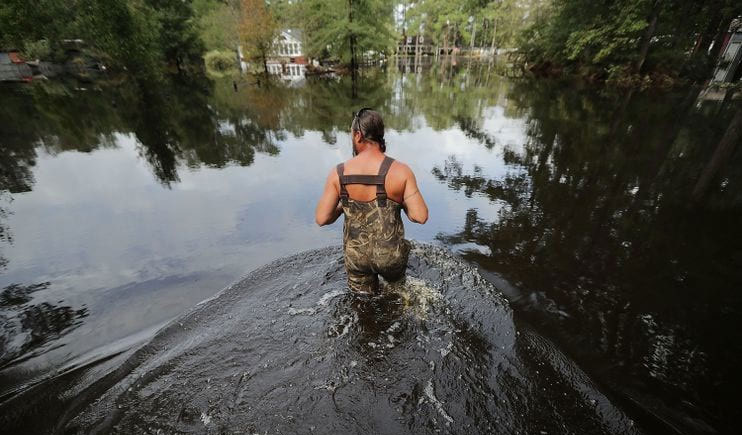Deadly dangers inside the floodwaters after super typhoon Florence
32 people died because of super typhoon Florence. And those who are still alive, they still suffer from the severe consequences of the storm, including deadly dangers.
Super Typhoon Florence has come across really a disaster for the people of East America. At the present time, water continues to rise in rivers, causing flooding in many areas.
People stuck in the floodplain are currently facing many problems: lack of medicine, food and clean water. Power lines collapse, people have to use generators, leading to a high risk of carbon monoxide (CO) poisoning. Water snakes raged, sharp debris floated in the water, the risk of infection and outbreaks of mosquitoes also appeared.
"That's right, there are bacteria, or snakes around," - Dan Lowry, a resident of Maxton (North Carolina), answers while wading through a pool of water up to his hips.

People stuck in the floodplain are currently facing many problems.
Lowry and his wife, both wearing shorts, barefoot. They were checking what was left in the garden behind their house in despair.
Deadly danger is what remains after the flood
Currently, the number of deaths from Typhoon Florence has reached 32. Most are drowned by the floods. And for those who are still alive, they still suffer from severe consequences after the storm, including deadly dangers.
"When the water reaches even meters, the drainage system starts to operate, creating dangerous whirlpools . The tragedy is that you won't see any signs on the water" - quoted David Persse, expert. Community health in Houston. Persse said a few years ago, there was a case of death by accidentally being sucked down into the drainage pipes.

Behind the floodwaters are terrifying threats.
"People just look at it and wonder: what's dangerous about water? What's the difference?" - Persse exclaimed.
But everything is like that. The water now contains toxic chemicals - often from household septic tanks. There are also cleaners, paints, chemicals in the garage, or even substances that . decompose people.
As reported by the EPA (US Environmental Protection Agency), there was a train loaded with butanol that fell right on the border between North and South Carolina. Fortunately, the chemical does not leak, but diesel has spread, polluting an area. Later, the lands here will take a long time to recover for agricultural and livestock activities.

Water flooded a house in Lumberton (city of North Carolina).
Next is the issue of medical relief . Tom Cotter, head of the regional relief team, said he has more than 100 dialysis patients waiting to be moved to Jacksonville - 145km from the floodplain. Among these people were people who had not been treated for more than 5 days as a result of the storm.
Disease is also a concern. According to Makoma Patahalla, a resident, he experienced the storm of Matthew in 2016. At the time of his rescue, he had a serious infection in both his legs and arms, painfully telling.
"It's not clear where the infection comes from," said Patahalla. Later doctors also cannot explain why.

Flooded water for too long also seriously damaged houses.
This is not the case. As in Hurricane Harvey in 2017, many people trapped in the flood have had intestinal infections, plus severe skin rashes. In addition, a strange disease caused by rare bacteria also broke out, causing hundreds of people to hospital emergency.
According to experts, animals such as rats, ferrets and some types of cattle may be the hosts that spread bacteria. Through water, people easily become infected if they have open wounds, or even simply get water into their eyes and mouth.
Flooded water for too long also seriously damaged houses. Mold grows and spreads rapidly within 48 hours, and people cannot live anymore.
And finally the mental damage . According to Jean Rhodes, a psychotherapist, many victims suffered a great shock. They must witness the devastating devastation of the storm, the death of relatives and houses washed away by floods . The losses cause too much stress, leading to depression and anxiety disorder later on. .

Psychological trauma after the storm is also extremely serious.
And more tragically, the same people may have to go through disaster again.
"It can be considered a shock, because these are too big events that you cannot overcome in a short time."
- Why do a series of super storms suddenly appear around the world?
- Watch this video, you will understand how dangerous Florence super typhoon is!
- From the space station, astronauts still shudder because of Florence Florence
- Thousands of fish covered the American highway after Typhoon Florence
- The 10 biggest storms recorded in history
- 9 storms occur at the same time, experts warn of 'abnormal'
- The question of the legendary 'Gray Man' ghost appeared in super typhoon Florence
- Amazing universe through the most impressive photos of 2018
- The first super typhoon of 2014: Super typhoon Neoguri flipped on the sea
- Big storms destroy the world
- The steps needed to survive the super typhoon
- The North urgently resisted Typhoon Haiyan
 'Fine laughs' - Scary and painful torture in ancient times
'Fine laughs' - Scary and painful torture in ancient times The sequence of numbers 142857 of the Egyptian pyramids is known as the strangest number in the world - Why?
The sequence of numbers 142857 of the Egyptian pyramids is known as the strangest number in the world - Why? History of the iron
History of the iron What is alum?
What is alum?